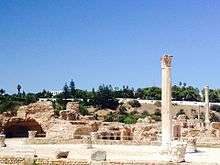Tourism in Tunisia
Tourism in Tunisia is an industry that generates around 7 million arrivals per year, which makes the country among the ones that attract the most tourists in Africa. Tunisia has been an attractive destination for tourists since the beginning of the 1960s. Among Tunisia's tourist attractions are its cosmopolitan capital city of Tunis, the ancient ruins of Carthage, the Muslim and Jewish quarters of Jerba, and coastal resorts outside Monastir. According to The New York Times, Tunisia is "known for its golden beaches, sunny weather and affordable luxuries."[1]
History
According to Garrett Nagle in his book Advanced Geography, Tunisia's tourist industry "benefits from its Mediterranean location and its tradition of low-cost package holidays from Western Europe."[2] The development of tourism dates back to 1960 through the joint efforts of government and private groups. In 1962, tourism, with 52,000 entries and 4,000 beds, had a revenue of two million dollars and becomes the main source of foreign exchange in the country.[3] Tunisia is also an attractive destination for its huge number of important festivals. The majority of these festivals occur in summer such as International Festival of Carthage which is the most important festival in the Arab world hosting stars and bands from all over the world, and Tabarka Jazz Festival.
Until recently, Tunisia's main attraction was on its northeast coastline around Tunis; however, the Seventh National Development Plan of 1989 created several new tourist areas including the resort at Port-el-Kantaoui.[2] The tourism sector now represents 6.5% of Tunisia's GDP and provides 340,000 jobs of which 85,000 are direct jobs or 11.5% of the working population with a high share of seasonal employment. France, Germany, Italy and the United Kingdom are the four traditional tourist markets, though Tunisia has decided since the last few years to open its tourism industry to new markets such as Russia and China.[4] From 2003-2004, it regained tourists, and 2007 saw arrivals increasing by 3 percent over that of 2006.[4]

Tourism in Tunisia suffered severe blows following the Bardo National Museum attack and the Sousse attack in 2015[5], but Tunisia managed to retrieve its position as one of the top destinations in Africa and the Mediterranean shortly afterwards, reaching in 2018 numbers exceeding those of 2010 by 6 percent.[6][7].
Attractions

Resorts
This sector is popular mainly on the east coast, totaling more than 95% of beds. The following is a list of the largest resorts and the percentage of nights out of the total:
New developments
In recent years, ecotourism, spas and medical tourism are emerging into Tunisia's tourist scene and growing very fast. According to the former Minister of Tourism Ahmed Smaou, "The medical tourism has a great future ahead of us."[8]
Statistics
In 2000, there were 197,400 hotel beds in roughly 95,977 rooms with an occupancy rate at 56%.[9] 5,057,193 travellers came to Tunisia that year.[9] That year, tourist expenditures were nearly $1.5 billion.[9] According to 2002 US Department of State estimates, the average daily cost of staying in Tunis or Carthage was $146, compared to $114 in other areas of Tunisia.[9]
A large number of tourists to Tunisia come from Eastern Europe, and the nationalities of major tourist countries is shown here: Libyans (1,472,411 visitors), French (1,234,735), Algerians (945,324), Germans (547,403), Italians (464,323) and British (350,693).[3] There were 1,251,251 domestic tourists staying across the country for 2.75 million nights in 2006.[10]
Recent years
| Year | Arrivals (million) | Earnings (dinar) |
|---|---|---|
| 2009 | 6.901.406 | 3.471,9 |
| 2010 | 6.902.749 | 3.522,5 |
| 2011 | 4.781.896 | 2.432,6 |
| 2012 | 5.590.464 | 3.175,3 |
| 2013 | 6.268.582 | 3.229,4 |
| 2014 | 6.068.593 | 3.575,6 |
| 2015 | 5.359.309 | 2.354,6 |
| 2016 | 5.724,021 | 2.322,9 |
See also
| Wikivoyage has a travel guide for Tunisia. |
References
- ↑ Elaine Glusac (22 November 2009). "A Night, and Day, In Tunisia at a New Resort". The New York Times.
- 1 2 Nagle, Garrett (2000). Advanced geography. Oxford University Press. p. 417. ISBN 0199134073.
- 1 2 Bouamoud, Mohamed (2007-11-12). "Radioscopie du Tourisme tunisien 2003-2006". Webmanagercenter (in French). Archived from the original on 2008-04-30. Retrieved 2008-05-27.
- 1 2 Heyer, Hazel (2008-03-12). "Tunisia tourism moves forward by sticking to the old". eturbonews.com. Retrieved 2008-05-27.
- ↑ Chetcuti, Kristina (9 July 2015). "Maltese strike Tunisia off destination list". Times of Malta. Retrieved 9 July 2015.
- ↑ Kraus, Nils (28 May 2018). "TOURISM IN TUNISIA IS FINALLY RECOVERING". Tourism-Review. Retrieved 30 August 2018.
- ↑ Tunisia sees tourism take off after terror fears
- ↑ Hoorman, Chloé (2005-01-10). "Le grand bain de la mondialisation". L’Express (in French). Archived from the original on 2008-02-28. Retrieved 2008-05-27.
- 1 2 3 4 "Tunisia: Tourism, travel, and recreation". Nations Encyclopedia. Retrieved 2008-05-28.
- ↑ Skander, Galia (2007-12-25). "Le tourisme intérieur : un vrai potentiel négligé". Tunisie Affaire (in French). Archived from the original on 2008-05-17. Retrieved 2008-05-27.

_(348982404).jpg)